Setting a Trend
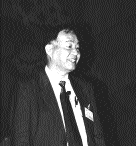
| Junichi Shimada Managing Director, Director of Research Institute Real World Computing Partnership |

| Junichi Shimada Managing Director, Director of Research Institute Real World Computing Partnership |
Today, I will discuss the target of the Real World Computing Program under the theme of "Setting a Trend." Most of you already know what the RWC Program is, yet for those not yet familiar with our initiative, let me begin by briefly explaining the concept.
In 1992, the Ministry of International Trade and Industry (MITI), started a 10-year project which would require an investment of some 70 billion yen in order to develop technologies which can process versatile information in the real world. This particular plan was named the "Real World Computing Program"(Fig. 1).
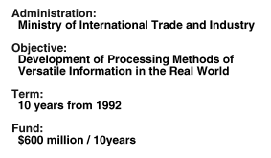
Fig. 1
What are the reasons behind the implementation of this project? (Fig. 2) As is well known, computers only accept information in predetermined formats. For instance, in Japan, word processors cannot provide the appropriate Kanji characters when words are entered that are not found in their built-in dictionaries, and so we must try to develop extensive dictionaries to process the various kinds of information that surround us. Yet even if such dictionaries could be prepared, it would take too long to search them sequentially from top to bottom. Thus, it can be said that current computers have "real world barrier" problems.
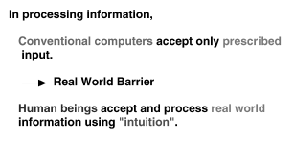
Fig. 2
On the other hand, humans can formulate rather appropriate answers within a certain time even to unknown problems. That is, humans are able to skillfully find an answer by taking into account a variety of experiences and the situations, using the ability called "intuition."
As is also well known, computers process information by converting a linear array of 1's and 0's into electrical current which changes in time and allowing it to flow into processors made of silicon. However, with this method it takes too long to process two-dimensional information like pictures, so this problem has been tackled by fabricating micro transistors in ever higher densities on silicon chips, thus increasing processing speed. However, this method also suffers from so-called "Silicon Limits."(Fig. 3)

Fig. 3
On the other hand, humans use rather low-speed brain cells, which act as information processing units. However, the huge number of these cells aligned in two dimensions in the cerebral cortex perform (almost certainly performing massively parallel processing) to achieve incredibly high speeds.
As stated before, humans seem to process information by a method called intuition. Let's stop and consider how such intuition can be implemented on computers (Fig. 4).
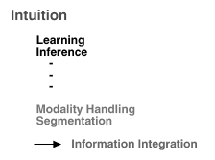
Fig. 4
The nature of intuition remains to be understood. It may consist of various composite functions, so we will not try to analyze intuition here. Suffice to say, intuition seems to involve reaching an answer by effectively combining various kinds of information, a function called "information integration." It is this function that we need to implement on computers.
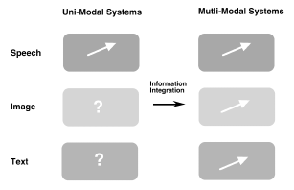
Fig. 5
Let's consider information integration (Fig. 5). Information which can be handled by computers includes numerical values, as well as speech, image, and text. Computers handle them separately. However, pictures may be more useful than speeches in certain circumstances, and vice versa. Or, only the combination of these may make the meaning clear. Animation is one such example; that is, by associating a speech dictionary, an image dictionary, and a text dictionary, it is possible to effectively use the combination of those dictionaries to provide an answer to a certain question. This is a typical example of information integration. Such methods have yet to be developed.
As stated before, we should focus on the massively parallel processing function of humans' ability to process information (Fig. 6).
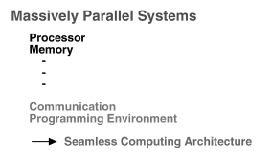
Fig. 6
In an attempt to realize this on computers, we must examine many things, and the method of communication among processors is seen as the main problem. This is because the conventional communication method based on a lengthy call procedure used by small-scale parallel computers is not adequate to bring thousands or even tens of thousands of processors directly into a cooperative system. This call procedure constitutes the so-calledÅgseamsÅhamong processors.
There are other seams besides these. For instance, in writing and running programs, materials at hand and those in other processors are used separately. This is one of the seams that must be removed.
Thus, a new field called "seamless computing" may develop.
Let's discuss seamless computing symbolically(Fig. 7).
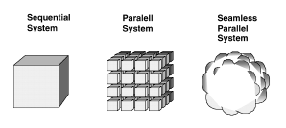
Fig. 7
Regular computers process information sequentially with a single processor. On the other hand, the conventional parallel computers use many processors to process information in parallel, with each processor maintaining independence and following a lengthy protocol in communicating with other processors. In seamless massively parallel computers, inter-processor communication is simply done over barriers, resulting in the integration of many processors. This is also true for the "seamless programming environment."
To realize such a concept, communication paths must be like highways. Fortunately, optical fiber communication technology has reached a point where it can be used for such a purpose.
The Real World Computing Program was initiated and has progressed based on such concepts. This project is designed not only to achieve the present objectives, but also to set new technical trends, and to create a new society (Fig. 8).
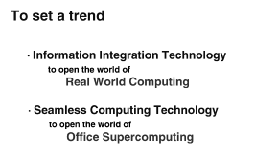
Fig. 8
One goal is to set a trend in information integration technology that will lead to developing a society where real world information can be handled by computers. Another goal would be to develop seamless computing technology to a point where people working in offices with only personal computers can get their jobs done as if they were using a supercomputer.
The technological fields under this project include (Fig. 9):
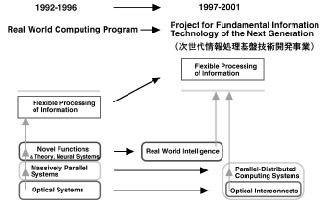
Fig. 9
- Novel Functions - This is directly related to achieving "flexible processing of information" by developing programs to be run on computers, and includes the development of Theory and Neural Systems. The main challenge here is to develop Multi-Modal Interactive Systems centered around the information integration technology.
- Massively Parallel Systems - This field will support Novel Functions as a platform and will include both hardware technology and software technology. The main challenge is to develop a communication methodology and programming environment for seamless computing.
- Optical Systems - The main objective is to provide a means of interconnection in massively parallel systems.
After the first five years of the project, it was decided to consolidate the fields related to Novel Functions as "Real World Intelligence", and to consolidate Massively Parallel Systems and Optical Systems as "Parallel and Distributed Systems, and to continue aiming to" Realize Flexible Processing of Information" after the project. Each of these fields was separately developed during the project.
This project is under the administration of MITI and guided by the Promotion and the Evaluation Committees. The research and development activities are mainly consigned to the RWC Partnership (Fig. 10). In addition, the Electrotechnical Laboratory conducts leading-edge research in the project.
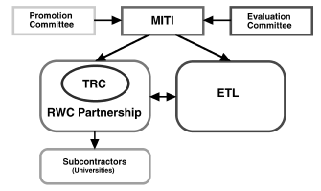
Fig. 10
The Tsukuba Research Center was set up in the Real World Computing Partnership, and serves as a focal point of cooperation for the Distributed Laboratories set up within the participating companies.
Some of the academic research to be covered by the project is subcontracted to universities and public research institutions by the Real World Computing Partnership.
So far, this project has produced many results, including (Fig. 11):
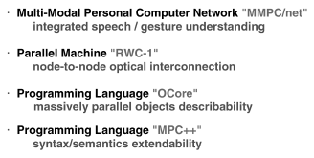
Fig. 11
- Multimodal interactive personal computer "MMPC/net". This is the world's first PC that understands by combining words and gestures.
- Massively parallel computer "RWC-1". This computer features the integration of processing and communication, with a trial fabrication of optical inter-processor connection, the first such attempt in the world.
- Programming language "OCore". This features the ability to describe massively parallel objects.
- Programming language "MPC++" is still under development. This is a massively parallel programming language which features extendible language functions.
This then outlines how we are promoting the Real World Computing Project and hopefully clarifies which part of the project we need your understanding and cooperation.